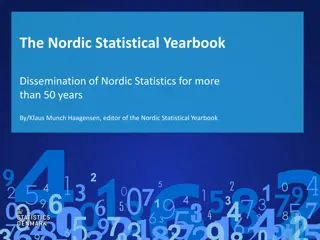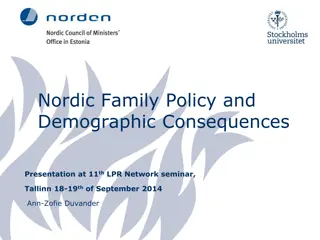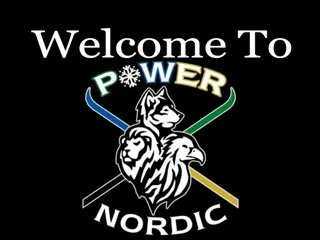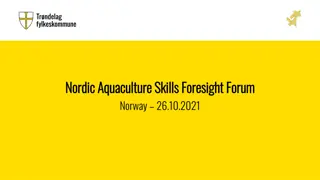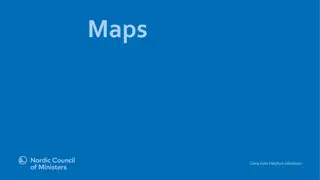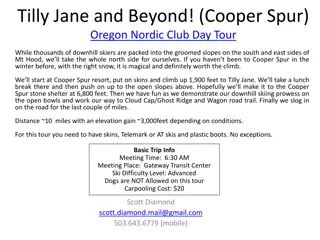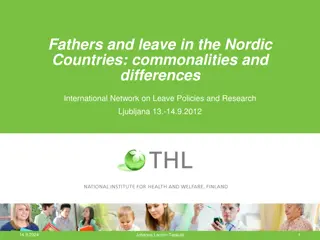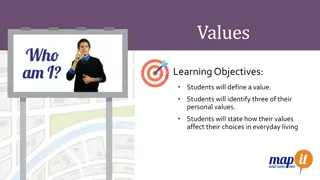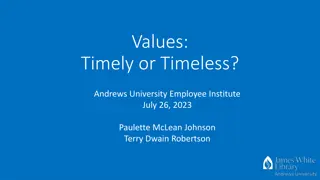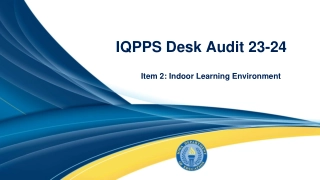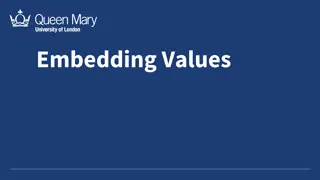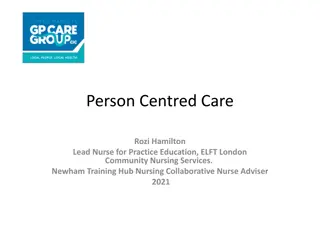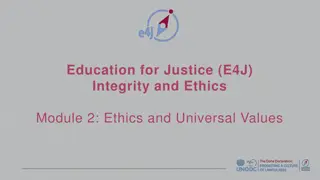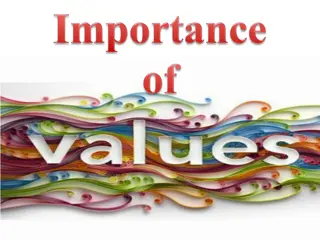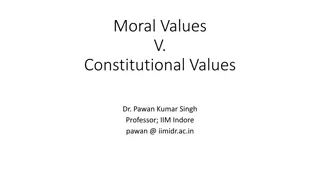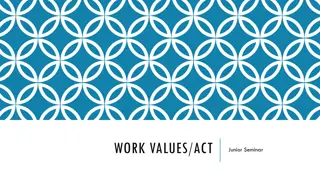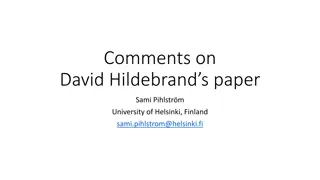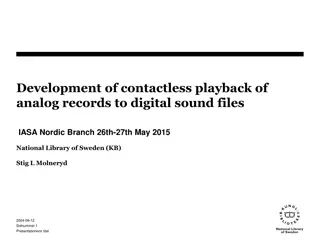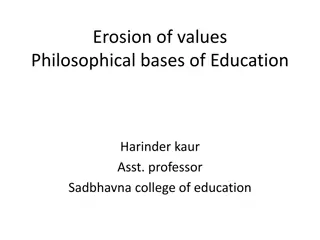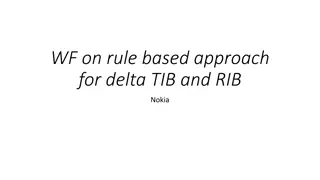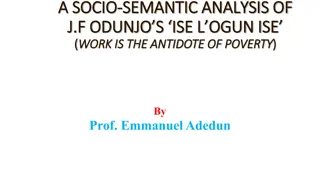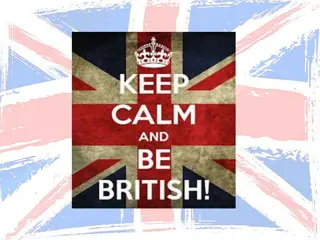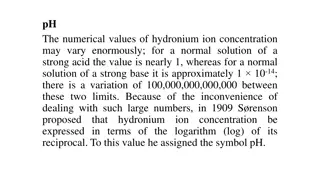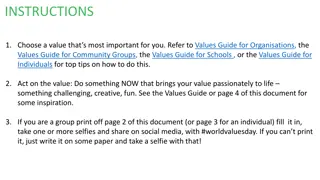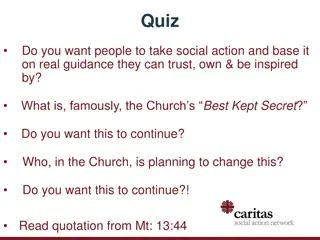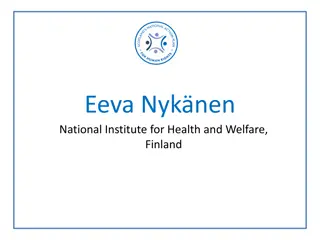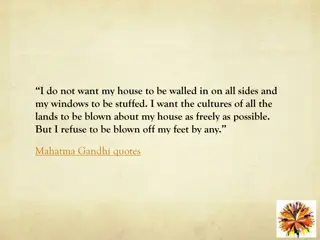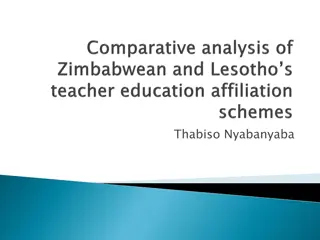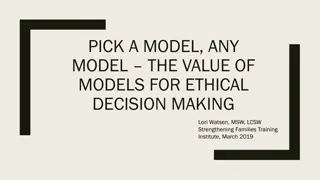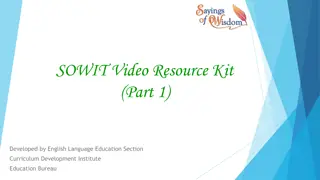Exploring Values Education in Nordic Preschools
This study delves into the perception and handling of values in Nordic preschools, focusing on caring, disciplinary, and democratic values. It aims to uncover whether conflicting or co-existing values prevail within individual preschools and across Nordic countries. Definitions of values, including democratic, caring, and disciplinary, are provided, along with insights into different forms of democratic values observed in preschool interactions. The study seeks to generate new knowledge on values education and its impact on children's learning and development.
Download Presentation

Please find below an Image/Link to download the presentation.
The content on the website is provided AS IS for your information and personal use only. It may not be sold, licensed, or shared on other websites without obtaining consent from the author. Download presentation by click this link. If you encounter any issues during the download, it is possible that the publisher has removed the file from their server.
E N D
Presentation Transcript
EECERA conference 2015 Barcelona CONFLICTING VALUES OR CO- EXISTING VALUES? Ole Henrik Hansen, Stig Brostr m and Anders Skriver Jensen Aarhus University, Department of Education Denmark
The Nordic Preschool project: Values Education in Nordic preschools The aim of the entire project is to explore how the practitioners perceive and deal with values in theory and practice and with specially focus on caring, disciplinary and democratic values.
The aim of the study on conflicting values The study aims to generate new knowledge on conflicting or similar values in Nordic preschools and Nordic countries. Do we see conflicting values in the individual preschool and between countries? Or just co- existing values?
Value definition We define values as principles that guide human actions and by which actions are judged to be good or desirable (Halstead and Taylor 2000) Values education as a concept refers to educational practices through which children are assumed to learn values as well as norms and skills grounded in those values (Halstead and Taylor 2000; Thornberg 2008)
Definition of three values Democratic values are related to influence, rights, freedom, co-determination and solidarity. Democracy deals also with a solidary and emphathic life style. Caring values in preschool describes a special relationship that can be characterized as actions that target and support the child s needs. Disciplinary values in preschool are defined as the system of underlying rules, norms and existing order which regulate children in order to act in a harmonious way in a specific social context. That means to find a balance between adjustment and self-dependence.
Two forms of democratic values Resistance-related patterns of interaction in which children resisted expectations of active participation Mutuality-related interactions, in which children seek to engage and participate in shared activities and in which the practitioners take children s perspective
Four forms caring values Educational caring where children s learning is close connected to care Disciplinary caring in order to support children s positive interaction with other people Care as recognition where practitioners share children s intentions Democratic caring characterized by children s learning about the surrounding world.
Five forms of disciplinary values Social supporting disciplinary values are expressed in actions where the practitioner uses her authority to govern children s social interactions in order to include invisible children. Competence supporting disciplinary values are expressed when the practitioner uses her authority in order to support children s learning. The practitioner makes up conditions and social interactions which make it possible for children to achieve knowledge, skills and new behaviour. Protecting and harmonization disciplinary values are expressed when the practitioner uses her authority to protect and support a child or a group of children when another child or a group of children threat their possibility to fulfil their motives and interests. Democratic disciplinary values have the function to create situations which allows every child and group of children to create actions where they are seen and heard and get possibilities to influence. The practitioner uses her authority to eliminate actions which hinder children s participation. Behaviour correcting disciplinary values, outside and authoritarian discipline
Denmark picture lottery The practitioner LOTTE started the picture lottery. She looked at the picture at a counter, a dog, and loudly she spoke out: Who have a dog? I have a dog a boy responded. LOTTE gave the boy his counter and she picked a new counter and said: I call for a bridge. A boy Alfred looked at the children across the table, and then the student SUSSY approached him: Alfred, look at your own plate. Who me? Alfred responded, and then he looked at his plate and expressed eagerly: Hey me . LOTTE throw the counter to Alfred. and approached him: Now listen. You have to look at your plate. It is not SUSSY, who shall check your plate, and control id you have the picture. In that case SUSSY would be the player, and not you. Do you understand? One more child, a girl Liva, enter the table. She placed herself at the table with her back towards the camera. LOTTE: Who have a pineapple? Immediately Liva pointed at Alfred s plate, and she said: There. Alfred had lost his concentration. He and Liva were involved in a play: They imagine they eat the plates. Alfred din not understand the fact, that he had the pineapple. LOTTE repeated the question: Who have the pineapple? Elisabeth leaned across the table and pointed at Alfred s plate, to which LOTTE responded with a correcting voice: Elisabeth . The girl looked at LOTTE and in a powerful way LOTTE shake her head saying: It is not you, who play the game . Elisabeth sat down at her stool and fiddled her fringe. Alfred smacked his hand on the table and expressed: I have a pineapple.
Sweden - mealtime EMMA, Tom, Linda, Agnes, Klara and Adam walk up to the low table to fetch the food. EMMA: We can fetch more ladles The children take the soup and make their sandwiches and EMMA stands ready to help if needed. Adam looks at Tom and comments: Oops, so much he takes! EMMA bends down and says to Tom: Can you eat all that? - Tom nods. EMMA: Oh well. EMMA sees that Agnes has got a lump of butter on her sandwich. She shows how Agnes can spread the butter on the sandwich. EMMA: It will be much tastier this way. EMMA: But you can try, Agnes said the same (inaudible) but see how well she has done. You can also try. I can look if there is anything I can help you with. EMMA says to Tom: What should one do to get it up (the lump of butter)? Klara: Like I do! Tom and EMMA look at Klara who spreads her sandwich. Then they look at Tom s sandwich and EMMA says EMMA: Shall I show you the same as I showed Agnes? EMMA takes the butter knife and Tom is looking at what she is doing. She says at the same time as she spreads the butter EMMA: If you take it (the butter knife) a little obliquely and then pull, then it becomes easier. EMMA gives Tom the knife and he tries again. Both EMMA, Tom and Adam look concentrated on the sandwich. Klara takes cheese on her sandwich. EMMA: If you first put a bit on the sandwich (she shows him), do like this. One must ensure that it (the knife) are close to the sandwich and then drag. Klara goes back to the other table. Emma gives the knife back to Tom and he tries again. EMMA: Can you see this? Then, pull lightly. Adam: I looked at Sven and I remembered it so I could do myself. EMMA: That is great. Either you can try. It's a good way to learn. Adam: If you look at someone who does as one should do. EMMA: It's also a great way to learn. One can learn a lot by watching how others do. One need not do all the mistakes yourself either. Tom has finished to put butter on his sandwich. He walks around the table to add on cheese. He moves his plate.
Finland dressing situation TANJA goes to the door of the toilet and says: Tiina, after you have washed your hands you should come here and not remain playing there . TANJA returns to the hall and puts Tiina s clothes on the floor in front of Tiina s locker (fleece pants, a fleece jacket, an outdoor suit, a hat, mittens, and woolen socks). TANJA helps other children and then goes to the door of the toilet again saying to Tiina: Now you must come, the other children should also wash their hands . Tiina comes to the hall, being clothed in green dungarees. TANJA says pointing to Tiina s outdoor clothes [and helping other children at the same time]: Tiina, there are yours [clothes], you can begin to dress yourself . Tiina sits down, lifts her tights, and looks at other children and TANJA. Tiina begins to put on woolen socks. First, she puts the legs of her dungarees inside the sock, then takes the legs away. She tries to adjust the legs many times without succeeding. She leaves the fleece pants on the floor and puts on the hat. TANJA helps other children and goes to the toilet every now and then. SAARA helps other children at the other end of the hall. TANJA comes to Tiina and asks: What are you putting on? [Tiina s answer unclear] Tiina is twiddling the hat in her hands. TANJA says: Yes, we will put on the middle layer clothes [not sure about the term], you have a fleece jacket and pants, it is a frost outside. TANJA goes away but returns after a while, kneeling near Tiina and saying: It is a frost. You ll take the fleece pants and put them on and then you ll take that jacket. Tiina answers, lifting her shoulders: I can t put on the fleeces! TANJA: We ll put on them. It is 13 degrees below zero! Tiina answers splaying her hands: I can t! TANJA asks: Why not? Tiina: I can t. Tiina lifts her tights. TANJA: You can put these [the legs of the green dungarees] inside the woolen socks, as you must put on the fleece pants. Tanja stands up and sits down on a bench near Tiina. TANJA: It s not warm any more . Tiina tries to put on the woolen socks and says: These go even worse! TANJA begins to help the other children. Tiina takes the woolen socks away. TANJA notes this and says: Tiina, you can t go out without fleeces . TANJA goes to help the other children. Tiina is annoyed and begins to whine, she throws the socks on the floor. Then she tries to put on the fleece pants, but the legs of the green dungarees go into a bundle. This irritates Tiina and she decides to take off the green dungarees. TANJA comes from the toilet and notices that Tiina has taken away the dungarees. TANJA: Tiina, Tiina, you can t take off the dungarees . Tiina throws herself on the floor and says with a complaining tone of her voice: But they are so nasty! TANJA: Then you have to put on some other pants. You can t go out with the mere tights . TANJA looks for another pants for Tiina, but does not find. She begins to help another child. Tiina twists on the floor throwing her clothes.
Finland dressing situation, cont. (7min) TANJA takes Tiina s dungarees and goes to talk with SAARA [their discussion is unclear]. Then TANJA comes to Tiina, puts the clothes in front of Tiina and states: Here . Tiina continues to twist and throws the dungarees away. TANJA helps other children and says: Tiina, it is so cold that if you put on just fleece pants you will get a pee infection . TANJA helps other children and Tiina continues to twist on the floor. (9min) TANJA goes to Tiina and says: You put on those, I will then help you. I will not give up, because it is so cold. TANJA goes to another room where SAARA is helping children to put on shoes. Tiina lies in front of the door of the toilet. The other children have to jump over her. Ella (3:5) says to Tiina: Do you remember that we had similar shirts on the name day? Tiina answers smiling: Yeah . SAARA comes from the other room and says: Tiina, are you going to go to the yard? SAARA goes near Tiina, kneels on the floor and says with a peaceful tone of the voice: Tiina, it is very cold outside. Do you need help with some clothes? Tiina is still twisting on the floor. SAARA takes Tiina s clothes into her lap and says: Look, you have that kind of tights and you need something more. SAARA picks up the dungarees and the fleece pants. SAARA: Which of these do you want to put on? Tiina shows the dungarees with her toe. SAARA: Okay, you will take these, let s put on these. TANJA asks: Do you mean that we ll put on just those? SAARA answers: I think that we ll put on just one pants and let s see if you will have cold or not . SAARA helps Tiina to put on the legs of the dungarees. Then Tiina continues to dress herself. (13min) SAARA helps Tiina to put on woolen socks so that the legs of the dungarees will not go into bundles. SAARA takes Tiina s fleece jacket: And then we will put on this, could you stand up? Tiina stands up and SAARA helps her. SAARA puts Tiina s outdoor suit on the floor and says: Now you must be a lot on the move. If you have cold you must certainly put these on in the afternoon, don t you? [pointing the fleece pants] Tiina nods and dresses in her outside suit. SAARA puts Tiina s hat and the mittens in front of her. SAARA helps Tiina to put on the hat and says [smiling]: You look so sweet, you have such a warm hat! SAARA gives the mittens to Tiina. Tiina goes to another room to put on her shoes. (16min)
Democratic values Denmark (pic lott) Sweden (meal time) Finland (dressng) Tiina initially resists TANJA s expectations regarding how to dress. Tiina succeeds in overturning these expectations (that she has to wear both the dungarees and the fleece pants), and comes out of the situation with a possible new identity: Instead of being the object of the adult s strategic communication, she is now a subject engaging in a compromise (she chooses which of the two clothes she wants to wear). dressngResistance related interactions Alfred and Liva establish a playful and meaningful interaction where they pretend to eat the pineapples. This interaction is not regulated by the norms currently governing the group as a whole (how a picture lottery is supposed to be played properly(?)). The adults seek to re-include Alfred and Liva in the dominating norm. The dominating order prevails, as Alfred displays the expected behavior towards the end. EMMA and the group are engaging in a common project, which is to master the art of spreading butter on a sandwich. EMMA facilitates a safe place for experimenting with spreading butter, guided by attention to the children, questions and praises for when the children help/look to each other. Mutuality related interactions
Caring values leads to Denmark Picture lottery Sweden - Mealtime Finland Dressing situation Alfred and Liva invents a new way to play a game on. LOTTE tries to get them to play the game by the normal rules. At the end Alfred begin to play the game as it should be played. EMMA and a group of children smear butter on bread. EMMA teaches children to smear. She also teach them how to avoid committing mistakes of others ( by observing others). Expression of educational caring values Expression of disciplinary caring values The Danish example could also be in this box The Finnish example could also be in this box In the Finnish example, there are two adults with two different approaches towards the same child (Tiina). TANJA tries to force Tiina to get two pairs of pants on because of frost outside. Tiina refuses. SAARA offers Tiina a way out of the situation and let her settle for one a pair of pants. The deal is, that if she starts to freeze, she can get another pair of pants on as well. Expression of recognition as caring values The Swedish example could also be in this box Expression fo democratic caring values The Finnish example could also be in this box
Disciplinary values Denmark (pic lott) Sweden (mealtime) Finland (dressing) Elisabeth helps Alfred, and the LOTTE says: It is not you who lay the game Social supporting disciplinary values LOTTE: Now listen. You have to look at your plate. It is not SUSSY, who shall check your plate EMMA: Shall I show you the same as I showed Agnes? EMMA takes the butter knife and Tom is looking at what she is doing. She says at the same time as she spreads the butter SARA: Do you need help with some clothes? Competence supporting disciplinary values Protecting and harmonization disciplinary values Elisabeth helps Alfred, and the practitioner says: It is not you who lay the game EMMA gives Tom the knife and he tries again. Democratic disciplinary values TANJA saying to Tiina: Now you must come, the other children should also wash their hands . Behaviour correcting disciplinary values
What to conclude? The research questions: The study aims to generate new knowledge on conflicting or similar values in Nordic preschools and Nordic countries. Do we see conflicting values in the individual preschool and between countries? Or just co-existing values? This is only an analyze of a little part of the data material Based on that we mostly see similar values in Nordic preschools and Nordic countries - there is no typical differences between the Nordic countries.


